Chapter 2
Uncovering Buyer Personas
IN THIS CHAPTER
 Understanding how personas enhance marketing efforts
Understanding how personas enhance marketing efforts
 Uncovering data types to investigate
Uncovering data types to investigate
 Collecting the right information
Collecting the right information
Nothing is more important for you as a digital marketer than understanding your customers. Without such understanding, you can’t develop content or make your product indispensable. Enter the use of buyer personas. Marketers have a love-hate relationship with them. They know that they need to create and use them, but they find personas difficult to develop.
Creating personas can be tricky. You can’t treat them like lifeless customer profiles that are created once and pulled out only for quarterly meetings. Buyer personas represent who your customers are. You have to understand who they are and what they care about. When you create persona documents, you should realize that they change as your company changes.
In this chapter, you look at how to develop personas that play a critical role in your content marketing efforts. You also see how to avoid making common mistakes.
Reviewing Persona Development
The persona concept is not a new one. It was first mentioned by Alan Cooper in his 1999 book The Inmates Are Running the Asylum (SAMS). In the book, Cooper talks about how one needs to discover customer personas rather than create them from untested assumptions. When you create a persona, you mix your own customer data with your understanding of the marketplace to represent your ideal buyer. This is key because if you make assumptions without having real data to back them up, you risk derailing your marketing efforts.
If you’re like many marketers, the concept of personas makes you uneasy. Chief among the reasons for this uneasiness is that personas aren’t easy to create or maintain. Your customer constantly changes her opinions, likes, and behaviors. You therefore have to keep abreast of her needs and wishes.
According to a 2015 joint study done by Quantcast and Forbes, 54 percent of companies agree that for audience targeting, identifying the proper personas is their biggest challenge. So you’re not alone in your quest to get personas done right. They are complex and can’t be tossed off quickly.
Understanding how persona creation improves content
The work of developing personas involves a combination of art and science. You need hard data to justify your conclusions. You also need a sense of how that data translates into customer emotions and actions. If you have a poorly constructed set of personas, you may do more harm than good.
The first question you may have as a marketer is whether your content benefits from using buyer personas. Does it really matter if you haven’t developed personas for your teams to focus on? The good news is that developing personas greatly improves the content you create. Read on to see how.
When you use personas, you can:
- Tap into feelings and emotions in your copy. After you understand how your buyers want to feel when they use your product, you can evoke those feelings with your content.
- Use buying triggers in emails and real-time messaging. If you know your personas’ buying triggers, you can send your emails and messages at the right time to interest buyers. You can also make sure that the same content is on your website and anywhere else where your buyers find you.
- Directly address problems customers are experiencing. Solving problems for your customers is key to revenue generation. Your content, in all appropriate formats, should focus on problem solving.
-
Use influencers to persuade customers. Obviously, knowing who your customers respect and listen to is an important piece of the content puzzle. You want to include influencer endorsements in your content when possible.
 Want a great way to find out which influencers resonate with your content? Onalytica (
Want a great way to find out which influencers resonate with your content? Onalytica (http://www.onalytica.com), shown in Figure 2-1, lets you upload a file or add a link to your content and then sends back a roster of influencers who would be interested in that content. It’s also great for finding influencers and new Twitter followers. Onalytica has lots of interesting uses and is free to try. - Rank content priorities. Personas can tell you what is most important to your customers. This is helpful when you have to create an editorial calendar that reflects true customer interest. Some content topics can be categorized as “nice to have” and others a “top priority.” For more information on editorial calendars see Book 3, Chapter 5.
- Speak to life goals that customers care about. Personas tell you what life goals drive customer behavior. If your product can be linked to those goals, you will have attention-getting content.
- Focus on what your customers want instead of what they say they want. When you understand persona motivations, you can focus your content on what they really care about rather than what customers say they want. Customers don’t always know what they want until they see it. By focusing on content that fits buyer personas, you won’t waste time.
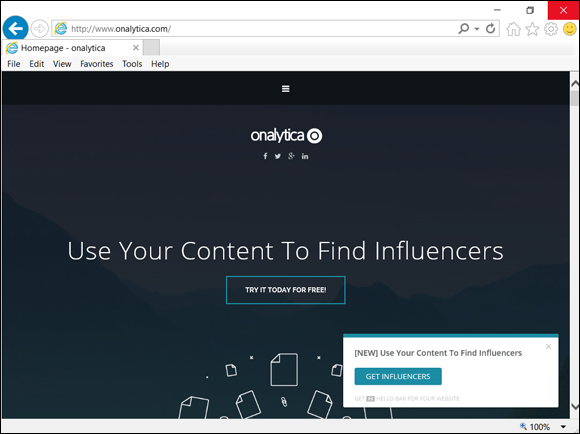
FIGURE 2-1: Onalytica.
Taking action to understand your customers
One of the main reasons that personas are hard to create is that you just can’t sit quietly in your office and look at data. You need to take action to gather everything you want to know.
Here are some actions you need to take:
- Meet actual customers on a regular basis. Customer feedback is crucial. You need to know what they think, how they view your company, and how and why they use your products. Meeting real customers can be frightening to some. You don’t want to say anything that might upset them. But if you can be regularly in touch with some of your clients, you can learn almost everything you need to know about how to make your products better.
- Dig for special data. You need to look at the data that is currently being collected by your company. Unfortunately, you may not find what you need. For this reason, you must be proactive and request the type of data that you require. Don’t assume that it doesn’t exist. The more likely scenario is that no one has ever requested it before.
- Look at content consumption. One key piece of data for every piece of content that you own is what the prospect has done with it. For example, if it’s a video, was it watched to the end? More than once? Was it forwarded to a colleague? When you see how the content was consumed, you can get a better handle on whether it hit the mark and how interested the prospect is in receiving more.
-
Review sentiment analysis. What is sentiment data? It’s user-generated content about your company and its services. This is also called opinion mining. You can set up a formal system to analyze this data, or if you are working on a smaller scale, you can look at actual customer comments.
For example, you may have lots of comments about your customer service on Twitter. If you see that the majority are complaints about how long your company takes to get back to customers, the sentiment is negative. On social platforms, not all publicity is good publicity.
-
Do what you ask your customers to do. This should be a hard-and-fast rule. You may think it’s only tangentially related to content creation, but if so, think again. You and your team should use your websites, landing pages, and blogs in the exact way you ask your customers to use them.
Although this seems like common sense, you’d be surprised at how little most marketers know about the actual workings of their own sites. For example, if something is hard to understand, you want to add content right in that spot online that makes it easier. If you haven’t used the site, you don’t know what you need to add to make it better.
- Make sure that content creators know your keywords, and keep content creators updated about any revisions you make. It’s important that all your content creators know what keywords you’re using. It helps them shape the content they create and makes them aware of what you’re trying to accomplish. Also make sure to keep them abreast of changes. This may seem like a small detail, but it will help them generate new ideas suited to your audience.
- Make support people and sales your front line for feedback. When you get your customer service people and sales reps to give you constant feedback, you’re giving yourself a competitive advantage. You want to continually create content that solves problems. By knowing what people are struggling with and by providing answers, you are directly affecting customer satisfaction.
- Talk to all your company stakeholders. The last thing you want to do is miss out on the wisdom that other departments can provide about your customers. Engage them and let them know what you’re doing. You will also establish some good will around the company by seeking out others’ advice.
Collecting Information
What types of data should you mine to gather information for your personas? The list goes well beyond the usual prescription to conduct one-on-one interviews. If you take the time to collect different types of data (see the upcoming Table 2-1), you gain the added insight you need to serve your customers.
TABLE 2-1 Data for Persona Development
|
Data Type |
Examples |
Suggested Places to Find It |
|
Demographic/ socioeconomic |
Age, gender, education, income, standing in the community |
Customer surveys, government data, Quantcast, comScore, Nielsen, Experian Simmons |
|
Psychographic |
Habits, values, hobbies |
One-on-one interviews, social media platforms, customer surveys, buying patterns, forums, blog comments, Google Analytics |
|
Trend information |
Popular culture |
TrendSpottr, Trend Hunter, BuzzSumo, magazines, online news sites, TV shows, Google trends, customer surveys |
|
Questions/pain points |
Questions customers are asking/jargon they are using |
Quora, Yahoo Answers, Stack Exchange, Wiki answers, blog comments, internal customer support, Google Analytics, customer events, conferences, sales team and other internal departments |
|
Social media content |
Twitter, Facebook, others |
Social Mention, Google Alerts, TweetReach, |
|
Internal customer records |
Buying patterns, product usage |
Internal company reports, CRM systems |
|
Search |
Keywords |
Google Analytics, Google Autocomplete, Ubersuggest |
|
Gated content |
Lead generators |
Top-ten lists, tool lists, ebooks, PDFs |
Finding different data types
Table 2-1 shows some recommended types of data that you should seek out when creating your personas.
Table 2-1 contains a reference, in the last row, to gated content. That is content that requires an email address in exchange for viewing it. This type of content is being used for a variety of content. According to MarketingCharts, shown in Figure 2-2, data from KoMarketing, Huff Industrial Marketing, and BuyerZone indicated that customers are willing to complete a form to get the following type of gated content (http://www.marketingcharts.com/online/b2b-vendor-websites-whats-important-and-whats-lacking-53697/):
- Trial offers
- Product demos
- Product evaluations
- Research
- Brochures and data sheets

FIGURE 2-2: MarketingCharts data from KoMarketing, Huff Industrial Marketing, and Buyer Zone.
Deploying listening tools
Smart content marketers know that listening to their customers is crucial. That’s why good listening tools are available online. A listening tool is a tool that helps you find out what your customers are saying online about you and your brand. For example, if someone mentions your brand in a tweet, you want to know about it. These tools help you find those mentions and comments. Here are a few tools that will help you stay in touch with what your customers are talking about:
- Social Mention (
http://www.socialmention.com): Shown in Figure 2-3, this is a great, free, real-time tool that monitors the web and social media. Type your topic and you get back information on sentiment, top keywords, top users, top hashtags, and sources of content. - Google Alerts (
http://alerts.google.com): This tool, shown in Figure 2-4, is very easy to use. Put in the names or product brands you are interested in, and you’ll be notified when they show up. - TweetReach (
https://tweetreach.com): This tool helps you monitor everything happening on Twitter related to your search (see Figure 2-5). It includes your topics, hashtags, competitors, and accounts. - Quora (
http://quora.com): This is a different kind of listening tool (see Figure 2-6). Use it to see what people are asking about your topic. It gives you a good perspective on how people approach a topic and what really concerns them. You will also find interesting answers to these questions from other users.
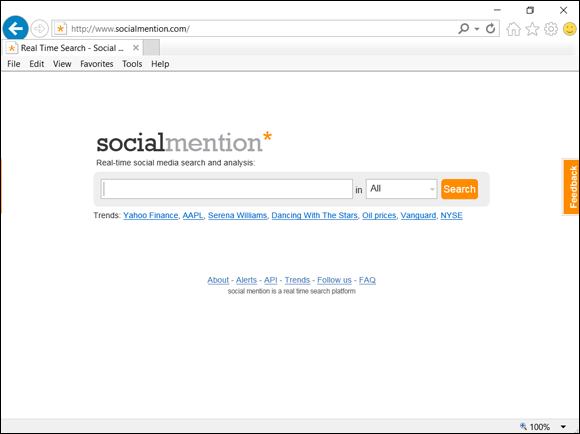
FIGURE 2-3: Social Mention.
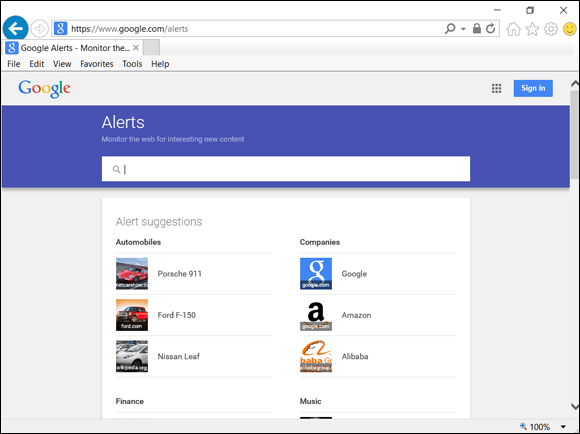
FIGURE 2-4: Google Alerts.
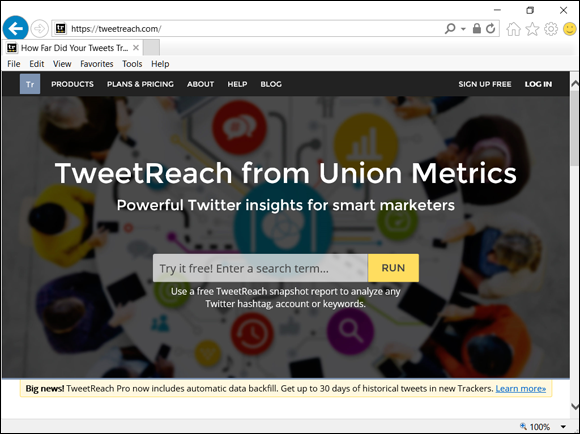
FIGURE 2-5: TweetReach.
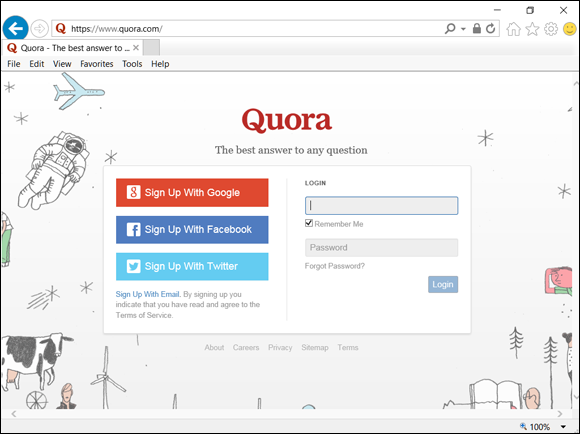
FIGURE 2-6: Quora.
Conducting one-on-one interviews
Interviews with your customers can be the cornerstone of great persona creation. If your company has the time and inclination to approve this activity, don’t hesitate to jump in. Meeting and asking your customers for their thoughts and opinions will help solidify your understanding of how your products are bought and used.
The wrinkle in your plans may come from other departments, such as sales. Sales may welcome an opportunity to introduce you to customers — or that department may be less than enthusiastic. If you’re in a small company without a sales force, this may not be an issue. Marketing and management may be one and the same. Obviously, the best thing to do is to follow the guidelines your company sets. If prohibited from interviewing customers directly, you can still create personas that can be useful by using some of the tools listed previously in Table 2-1.
When you’re conducting an interview with your customers, you want to ask them questions that will put them at ease and capitalize on their experience with buying and using your product. Make sure to probe for the meaning behind the answers.
You also want to make sure that you collect all the pertinent demographic data such as age, job title, income, and other information. You can then move on to questions that pertain to your products. Of course, your specific questions relate to whether you’re speaking to a B2B customer or a B2C customer. Typically, you will want to know your customers’ questions about the following:
- Life goals and personal motivators
- Goals for using the product
- Things they don’t like about the product or your company
- People who influence their buying behavior
- Triggers that cause them to buy
- Where they consume their information and how they find new products
- What other products they tried before choosing yours
Documenting your personas
The way you present your personas will go a long way toward getting internal acceptance. If you have a receptive audience, you can use a typical template that includes a name, a picture, and details.
If you have a skeptical audience that resists the idea of using personas, you may want to start with a document that doesn’t use the word persona and gives a generic style title and no picture. For example, you call it a customer profile and give it a name that reflects their characteristics, such as Anxious Parent. This would not be your preferred method, but getting acceptance is key to moving forward.
Unfortunately, some people do strongly resist using personas, so you’ll want to move slowly. You’ll know pretty quickly if you’re dealing with this kind of audience.
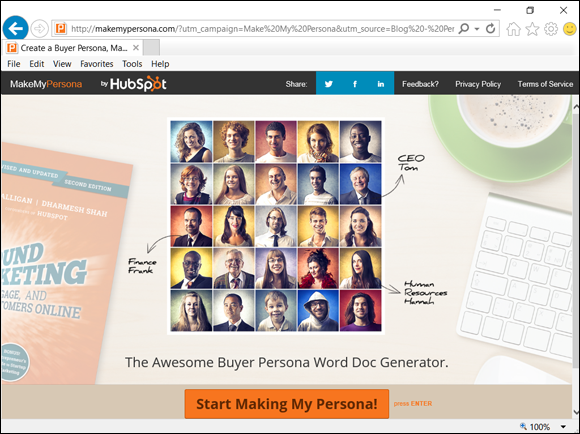
FIGURE 2-7: HubSpot’s Make My Persona tool.
Avoiding Common Mistakes
As mentioned previously, creating personas is not easy. You and your team can make several mistakes along the way. Here are six common ones that you can make when creating your buyer personas:
-
Mistaking yourself for the customer. You begin telling your manager or colleague about a solution to your customer’s problem. You have researched the data and the marketplace and believe that this information should be added to your persona. Your manager shoots down your idea because he doesn’t believe that you’re right.
He bases his opinion on the fact that it’s not how he thinks about the problem. He forgets that he’s not the customer. This is a very common problem. People who work closely with products begin to think that they are the customers. In reality, they would never be a purchaser of the product.
- Listening to what someone’s relative thinks is a good idea. Someone’s relative has a strong feeling about something, and your colleague is swayed by their opinion and wants to make it part of the persona. But your “favorite” features should not be based on what your colleague’s cousin likes.
- Forgetting to collect data about the customers who didn’t complete their purchase. You can often learn just as much from customers who didn’t complete the purchase of your product as you can from those who did. You need to know why your customers abandoned their shopping cart in mid-buy. This is extremely helpful because you want to know where you’re falling short and what you can do to plug that leak. This data should be included in persona information.
- Thinking that understanding the features and benefits that personas prefer is the whole picture. Most product managers love their products. That’s a good thing. But customers unknowingly want you to appeal to their emotions. When you don’t understand how the product makes them feel, you miss an opportunity to grab their imagination and create a customer for life.
- Not understanding what entertains your customer. You spend time collecting information, but you don’t find out what your customer finds entertaining. If you know more about this, you can create great content pieces that will engage your prospects. You also need to know where they consume information and in what format.
- Ignoring what people don’t like about your product. Obviously, you focus on what they do like so that you can appeal to prospect. But you also want to know what they don’t like so that you can fix it and retain customers.
Looking at How Generations Differ
Every generation puts its definitive stamp on society. In this section, you look at two groups that have a major impact on your content marketing efforts — Millennials and Generation C.
Understanding Millennials
According to a Pew Research Center study, shown in Figure 2-8, 2015 was the year that Millennials became the largest generational group in the United States, surpassing baby boomers (http://www.pewresearch.org/fact-tank/2015/01/16/this-year-millennials-will-overtake-baby-boomers/). Millennials are defined as those who were ages 18 to 34 in 2015. The oldest millennial was born in 1981.
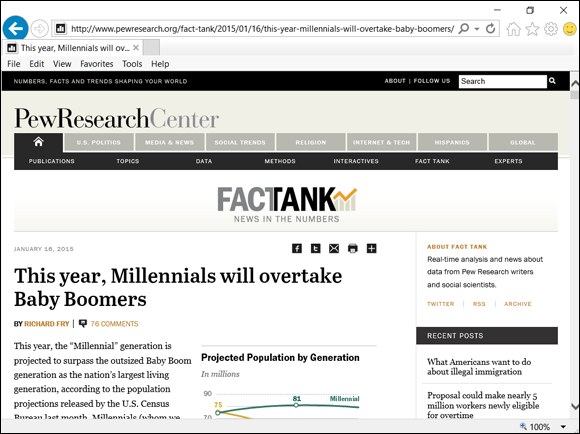
FIGURE 2-8: Pew Research Center study.
Much has been reported about how Millennials differ in their attitude toward marketing and technology. They have grown up with digital gadgets and aren’t intimidated by them. They can easily spot hype and are resistant to it in marketing messages. They like to be asked to participate by companies and are more likely to take the advice of another millennial they don’t know rather than be influenced by a popular brand.
According to a 2016 eMarketer article about Ipsos research, Millennials spend an average of 53 hours per week online, more than any other generation (https://www.emarketer.com/Article/Among-Affluents-Millennials-Spend-Most-Time-Online/101461).
In an attempt to understand how Millennials view content, NewsCred conducted an important study called “The Millennial Mind: How Content Drives Brand Loyalty” (https://www.newscred.com/wp-content/themes/newscred/assets/downloads/guide/NewsCred_Millennial_Mind.pdf); see Figure 2-9).
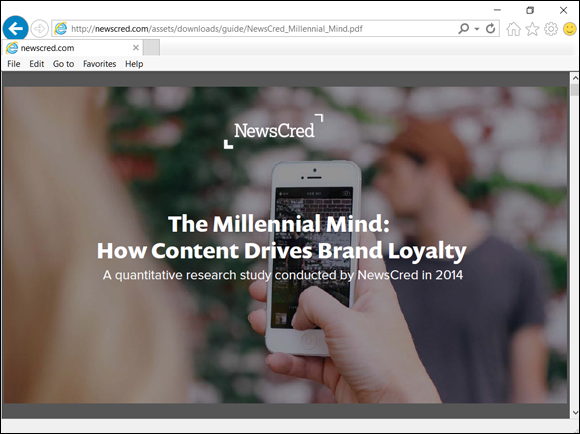
FIGURE 2-9: The NewsCred Millennial study.
Here are some of the study’s key findings:
- A majority of the Millennials surveyed favor content that is tailored to their age, location, and cultural interests.
- Thirty percent don’t read content unless it educates or entertains them.
- Forty-one percent abandon content that is too long.
- Seventy percent share content that makes them laugh.
- Google and Facebook are the top platforms they use to find content.
- Fifty percent share content about a cause they believe in.
- More than 50 percent prefer to engage with brands on their company websites or social media.
So what does this mean for your content efforts if you’re targeting Millennials? Obviously, they’re a discerning group. They want the content they engage with to be age appropriate and to have some intrinsic value. They won’t normally sit through long content, but you can catch their attention when you discuss their favorite causes. One interesting finding is that they will engage brands on their websites, not just on social media networks. This is an opportunity for you to beef up content on your website.
Meeting Gen C
An offshoot of the Millennials is a group called Gen C. Unlike Millennials, Gen C isn’t really a generation in the true sense of the term, but rather a construct made up of people who live their lives connected to their devices. They could be from any age group, but they have distinct characteristics. Sixty-five percent of them are under 35 but the rest are spread among the other generations.
Google identifies Gen C as consumers who care about the following:
- Creation: They like the act of creating content — taking pictures, giving their opinions, and sharing them online.
- Curation: They like gathering others’ interesting ideas, photos, and articles and sharing them with their friends.
- Connection: They want to stay connected, and 76 percent watch YouTube videos every day.
- Community: They want to belong to groups that do things they support and admire.
Surprisingly, Gen Cers interact directly with brands. If you’re a content marketer, you want to make sure that you engage these prospects by asking them to participate and take action.
Identifying a Prospect’s Emotions
The shift in control from marketers to prospects has created a strong need for marketers to figure out what a prospect needs at every stage of the buyer journey. (See the next chapter for more about the buyer’s journey.) One of the things that is central to your investigation of buyer personas is how your customers feel when they buy and use your products. It’s imperative to use emotional language in your content — that is, language that evokes feelings. Moods and emotions impact buying habits. People joke about shopping — dubbed retail therapy — as a way to soothe themselves. That’s proof that customers are influenced by their feelings. Both B2B customers and B2C customers are influenced by emotions even though business buyers would like to think otherwise. An awareness of emotions that affect your buyers can help you seek them out in your customers.
Here are some common emotions that influence buyers:
- Fear: You want to know what concerns and fears your customer may have so that when you write your content, you can show how your product would impact that fear. Will it help alleviate it? That’s a great motivator to buy.
- Guilt: Customers don’t always buy your product for positive reasons. Sometimes it will be bought to assuage someone or make up for the lack of something. Your content could highlight that emotion.
- Concerns about status: Of course, this is a big motivator. If you’re selling a luxury product, you want to make sure that you tap into the notion that the purchase of your product will elevate a buyer’s status. Conversely, if you’re aiming at a frugal buyer, you want to ensure that your content targets that mentality.
- Desire to mitigate risk: Whenever someone makes a purchase, they worry about taking a bad risk. If the product cost is small, the concern is lower, but it’s always there. If you can mitigate that risk in some way, such as by adding a money-back guarantee to your content, you can help your customer say yes.
- Desire for instant gratification: If this motivation is present, your content should focus on it. Every marketer loves an impulse buyer.
- Fear of Missing Out (FOMO): This is a relatively new addition (or addiction). People who are plugged into their devices have a fear that if they aren’t paying attention to online activity 24/7, they’re missing out on what’s happening. They want to know about the latest products, trends, events, and gossip. They want to know what their friends are doing and how they themselves compare. To capitalize on this phenomenon, your marketing can provoke users to feel that they have to have your product or risk being left behind.
Keeping Up with Trends
Keeping your eye on trends is an important part of a marketer’s job. You want to know what your customers are seeing, hearing, and thinking about in the wider culture. Sometimes trends come in with a huge flourish. Other times, they sneak up on you. Keeping yourself in touch with popular culture helps you know what your customers might want next or what they will reject.
Here are a few sources in addition to the listening tools discussed earlier in the chapter, in “Deploying listening tools,” to help you plug in to what’s happening around you:
- Google Trends (
https://www.google.com/trends): This is a free tool that lets you know what’s popular on Google, which is a sure way to know what people are interested in. Here’s a look at the term content marketing (https://www.google.com/trends/explore#q=content%20marketing). As you can see the trend spikes upward starting in 2011, as shown in Figure 2-10. - Trendspottr (
http://trendspottr.com): Shown in Figure 2-11, this tool allows you to create alerts for the topics you care about. It’s a real-time tool that keeps you on top of trends by monitoring web content, including that of Facebook and Twitter. - Trend Hunter (
http://www.trendhunter.com): Shown in Figure 2-12, Trend Hunter is a community of people who report on the latest trends. The site has lots of interesting information on what’s trending and why. - BuzzSumo Trends: BuzzSumo has added a trends section to its search capabilities, as shown in Figure 2-13. It shows you content that is trending for major topics or the specific topics you set up. To create your own trend search, go to
https://app.buzzsumo.com/trendingand set up the topic of your choice. You can see what’s trending in 2, 4, 8, 12, or 24 hours.
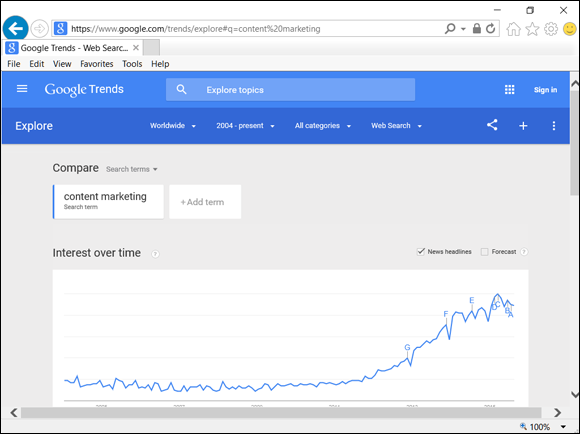
FIGURE 2-10: Google Trends for content marketing.

FIGURE 2-11: Trendspottr.
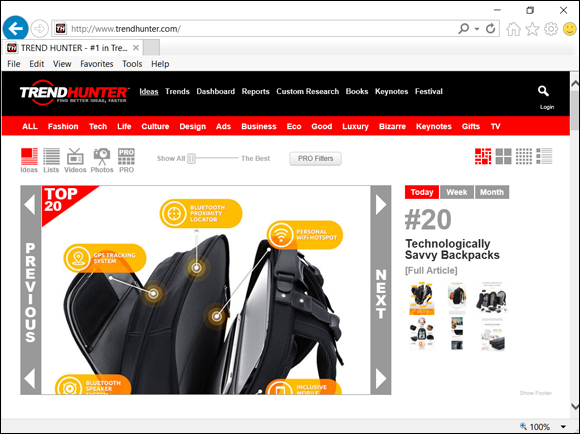
FIGURE 2-12: Trend Hunter.
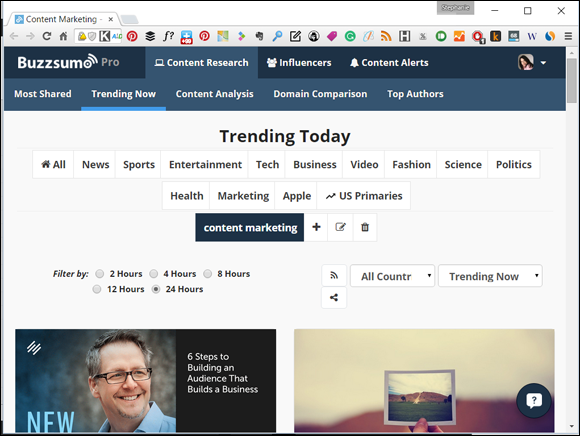
FIGURE 2-13: BuzzSumo Trends for content marketing.
 It’s important to recognize that customer profiles and personas are not the same thing. You can easily create a standard customer profile and think that the job is done. A customer profile will get you only so far, however. You can know a person’s age or gender but still not know what truly entices that person to buy your product. To know that, you need to dig deeper.
It’s important to recognize that customer profiles and personas are not the same thing. You can easily create a standard customer profile and think that the job is done. A customer profile will get you only so far, however. You can know a person’s age or gender but still not know what truly entices that person to buy your product. To know that, you need to dig deeper.